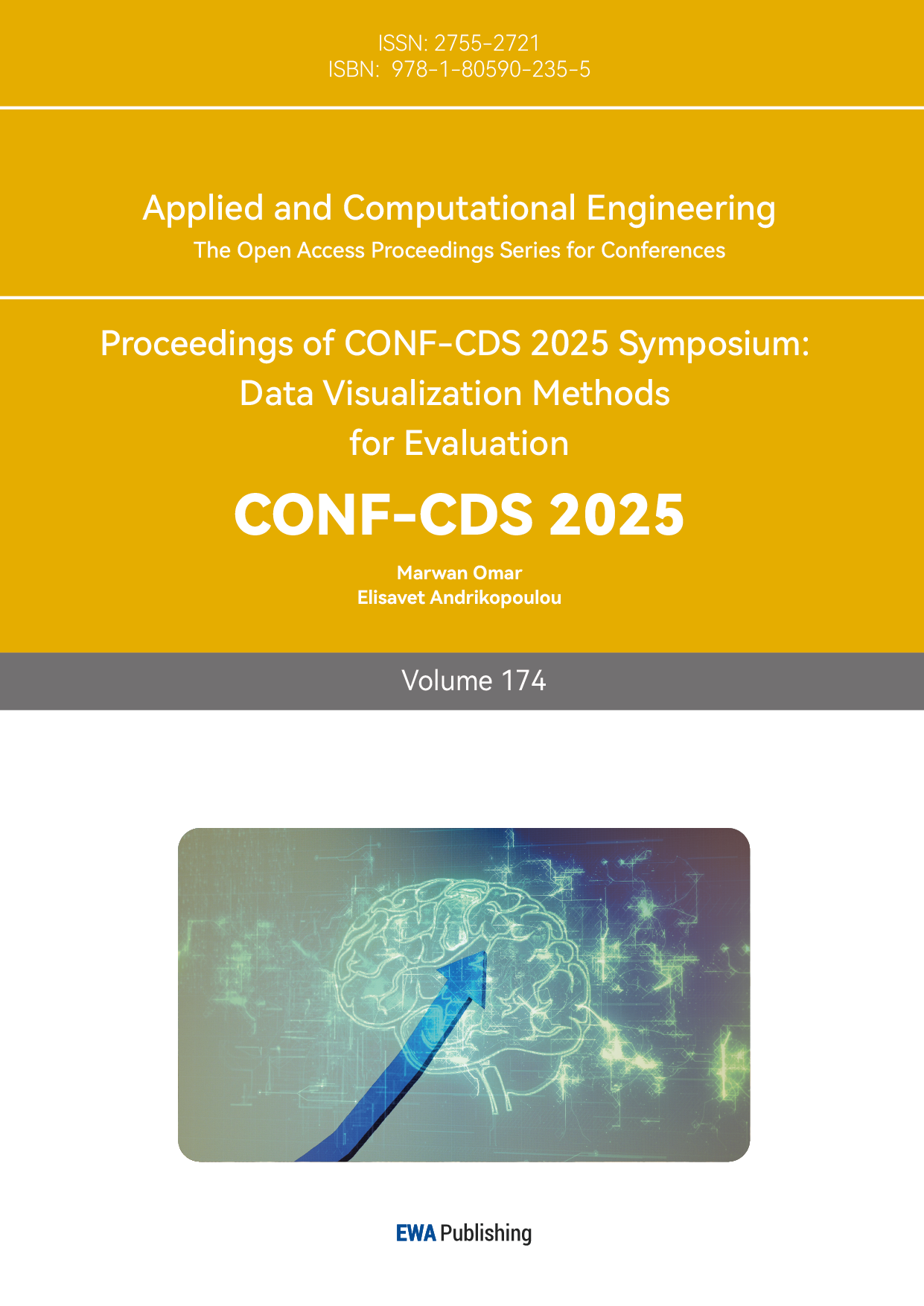References
[1]. Liu, X., Song, L., Liu, S., & Zhang, Y. (2021). A Review of Deep-Learning-Based Medical Image Segmentation Methods. Sustainability, 13(3), 1224. https: //doi.org/10.3390/su13031224
[2]. Cai, L., Gao, J., & Zhao, D. (2020). A review of the application of deep learning in medical image classification and segmentation. Annals of translational medicine, 8(11), 713. https: //doi.org/10.21037/atm.2020.02.44
[3]. Ker, J., Wang, L., Rao, J., & Lim, T. (2018). Deep learning applications in medical image analysis. IEEE Access, 6, 9375–9389. https: //doi.org/10.1109/access.2017.2788044
[4]. Shen, D., Wu, G., & Suk, H.-I. (2017). Deep learning in medical image analysis. Annual Review of Biomedical Engineering, 19(1), 221–248. https: //doi.org/10.1146/annurev-bioeng-071516-044442
[5]. Karimi, D., Dou, H., Warfield, S. K., & Gholipour, A. (2020). Deep learning with noisy labels: Exploring techniques and remedies in medical image analysis. Medical Image Analysis, 65, 101759. https: //doi.org/10.1016/j.media.2020.101759
[6]. Suzuki, K. (2017). Overview of deep learning in medical imaging. Radiological Physics and Technology, 10(3), 257–273. https: //doi.org/10.1007/s12194-017-0406-5
[7]. Shen, D., Wu, G., & Suk, H.-I. (2017). Deep learning in medical image analysis. Annual Review of Biomedical Engineering, 19(1), 221–248. https: //doi.org/10.1146/annurev-bioeng-071516-044442
[8]. Litjens, G., Kooi, T., Bejnordi, B. E., Setio, A. A., Ciompi, F., Ghafoorian, M., van der Laak, J. A. W. M., van Ginneken, B., & Sánchez, C. I. (2017). A survey on Deep Learning in medical image analysis. Medical Image Analysis, 42, 60–88. https: //doi.org/10.1016/j.media.2017.07.005
[9]. Lundervold, A. S., & Lundervold, A. (2019). An overview of deep learning in medical imaging focusing on MRI. Zeitschrift Für Medizinische Physik, 29(2), 102–127. https: //doi.org/10.1016/j.zemedi.2018.11.002
[10]. Long, J., Shelhamer, E., & Darrell, T. (2015, June). Fully convolutional networks for semantic segmentation. 2015 IEEE Conference on Computer Vision and Pattern Recognition (CVPR). https: //doi.org/10.1109/cvpr.2015.7298965
[11]. Chen, L. C., Papandreou, G., Kokkinos, I., Murphy, K., & Yuille, A. L. (2014). Semantic image segmentation with deep convolutional nets and fully connected crfs. arXiv preprint arXiv: 1412.7062. https: //doi.org/10.48550/arXiv.1412.7062
[12]. Chen, L.-C., Papandreou, G., Kokkinos, I., Murphy, K., & Yuille, A. L. (2018b). DeepLab: Semantic image segmentation with deep convolutional nets, atrous convolution, and fully connected crfs. IEEE Transactions on Pattern Analysis and Machine Intelligence, 40(4), 834–848. https: //doi.org/10.1109/tpami.2017.2699184
[13]. Chen, L. C., Papandreou, G., Schroff, F., & Adam, H. (2017). Rethinking atrous convolution for semantic image segmentation. arXiv preprint arXiv: 1706.05587. https: //doi.org/10.48550/arXiv.1706.05587
[14]. Chen, L.-C., Zhu, Y., Papandreou, G., Schroff, F., & Adam, H. (2018). Encoder-Decoder with atrous separable convolution for semantic image segmentation. In Lecture Notes in Computer Science (pp. 833–851). Springer International Publishing. https: //doi.org/10.1007/978-3-030-01234-2_49
[15]. Badrinarayanan, V., Kendall, A., & Cipolla, R. (2017). SegNet: A deep convolutional encoder-decoder architecture for image segmentation. IEEE Transactions on Pattern Analysis and Machine Intelligence, 39(12), 2481–2495. https: //doi.org/10.1109/tpami.2016.2644615
[16]. Ronneberger, O., Fischer, P., & Brox, T. (2015). U-Net: Convolutional networks for biomedical image segmentation. In Lecture Notes in Computer Science (pp. 234–241). Springer International Publishing. https: //doi.org/10.1007/978-3-319-24574-4_28
[17]. Çiçek, Ö., Abdulkadir, A., Lienkamp, S. S., Brox, T., & Ronneberger, O. (2016). 3D u-net: Learning dense volumetric segmentation from sparse annotation. In Lecture Notes in Computer Science (pp. 424–432). Springer International Publishing. https: //doi.org/10.1007/978-3-319-46723-8_49 October 17-21, 2016, Proceedings, Part II 19 (pp. 424-432). Springer International Publishing.
[18]. Milletari, F., Navab, N., & Ahmadi, S.-A. (2016). V-Net: Fully convolutional neural networks for volumetric medical image segmentation. 2016 Fourth International Conference on 3D Vision (3DV), 565–571. https: //doi.org/10.1109/3dv.2016.79
[19]. Xue, Y., Xu, T., Zhang, H., Long, L. R., & Huang, X. (2018). SegAN: Adversarial network with multi-scale L1 loss for medical image segmentation. Neuroinformatics, 16(3–4), 383–392. https: //doi.org/10.1007/s12021-018-9377-x
[20]. Dai, W., Dong, N., Wang, Z., Liang, X., Zhang, H., & Xing, E. P. (2018). SCAN: Structure correcting adversarial network for organ segmentation in chest x-rays. In Lecture Notes in Computer Science (pp. 263–273). Springer International Publishing. https: //doi.org/10.1007/978-3-030-00889-5_30
[21]. Krizhevsky, A., Sutskever, I., & Hinton, G. E. (2017). ImageNet classification with deep convolutional neural networks. Communications of the ACM, 60(6), 84–90. https: //doi.org/10.1145/3065386
[22]. Simonyan, K., & Zisserman, A. (2014). Very deep convolutional networks for large-scale image recognition. arXiv preprint arXiv: 1409.1556. https: //doi.org/10.48550/arXiv.1409.1556
[23]. He, K., Zhang, X., Ren, S., & Sun, J. (2016). Deep residual learning for image recognition. 2016 IEEE Conference on Computer Vision and Pattern Recognition (CVPR). https: //doi.org/10.1109/cvpr.2016.90



